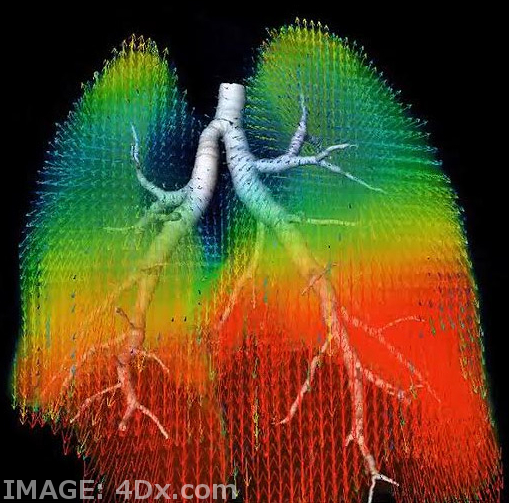Lung function filmed in 4D
 A Melbourne-based medical tech firm wants to improve vital imagery.
A Melbourne-based medical tech firm wants to improve vital imagery.
4Dx says its technology will mean big things for diagnostics and treatment of respiratory diseases such as lung cancer, Chronic Obstructive Pulmonary Disease (COPD), cystic fibrosis, asthma, and black lung.
The company is publishing results to prove it can be a game-changer.
In a new pre-clinical study, 4Dx’s four-dimensional lung diagnostic platform was used to measure the progression and severity of a cystic fibrosis (CF) like lung disease.
The advanced lung imaging technology uses X-ray images acquired simultaneously from different directions on existing hospital X-ray imaging systems.
Using image-processing methods adapted from aerospace engineering, the movement of the lung tissue from each view is collectively tracked.
The information is then combined to reconstruct the flow of air throughout all airways of the lung.
The technology uses images from a very limited number of different angles (compared to many hundreds of different angles in a full CT scan), so the radiation dose required is dramatically lower than CT.
The limited number of angles also means that scans can be captured in just a few seconds.
4Dx executive director Steve Peuschel was born with cystic fibrosis. In 2003, he became the recipient of a double lung transplant. He says it is urgent for early detection that doctors can see what is really important – how the lungs work.
“The problem with current lung diagnostics is that if you have something happening in one airway of the lung, the rest of the lung compensates. So with current diagnostics, you can get fairly normal results on the tests even when disease is progressing,” Peuschel says.
“Our technology provides images of the breathing lungs, allowing investigators to, for the first time, view and measure subtle changes in ventilation to specific areas of the lung as the disease progresses.”
Professor Greg Snell, head of lung transplant services at Melbourne’s Alfred Hospital, says it could be a major improvement in treating lung disease.
“This technology has great potential as a new tool for both early diagnosis and management of many very common lung conditions. I think this will be the start of a new way of thinking about diagnostic imaging,” Prof Snell says.
While there is no cure for cystic fibrosis, CEO of Cystic Fibrosis Victoria Karin Knoester, says the community is always interested in adding to the arsenal of tools currently used to help their members treat and manage their condition.
“Any tool that can identify damage at an early stage will be able to inform intervention, with the hope of reducing further damage.”
“Equally, anything that can more precisely measure the progression of the disease in the lung and improve outcomes is valuable to our members,” Knoester said.
More information is available in the video below, and the latest report on its use is accessible here.








 Print
Print